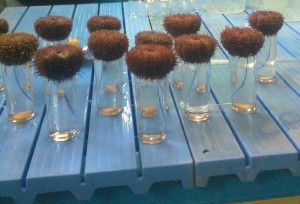Photo credit: Rodrigo Rivera González (Chile) Review: Abdel Rahman El Gamal
Introduction: The Chilean Sea urchins Loxechinus albus (Molina, 1782) is an edible echinoderm animal of the family Parechinidae. This species is native to the coasts of Chile and Peru and is considered among the key benthic herbivores in Chilean coastal waters. It is harvested commercially by fishermen and is considered an ingredient in Chilean cuisine. It is also known as “common green sea urchin” and its local name in Chile is “Erizo rojo” which means “red urchin”. They can grow up to 100 mm in diameter or more. It takes eight years for Chilean sea urchins to reach commercial size. The industrial catches and over-exploitation of the animal for canned gonads has caused the extinction of many local populations.
Distribution and habitats: The Chilean sea urchins have a wide geographic distribution along the Pacific coast running from northern Peru to Tierra del Fuego. The highest abundances and the commercial fisheries for Chilean sea urchin are in depth range of 20-30 m depth in Chile; their preference is for shallower habitats (0-10 m depth) buried in fine sand and muddy sand, beaches.
Feeding Habits: This species is herbivore that feeds -during day and night- on nearby algal pieces. Sea urchin juvenile consume significantly more benthic than floating algae pieces; kelp and other seaweed species which are their preferred food. When found in deeper habitats, sea urchins may feed on encrusting algae, benthic microalgae, and small invertebrates. In aquaculture, this animal feeds on prepared (extruded) feeds.
Note: We decided not to watermark the photos in order not to upset its clarity. However, we trust you will notify us if you wish to use a picture or more. This is expected and will be appreciated

